Chapter 2: Environmental influences
Chapter learning objectives
Upon completion of this chapter you will be able to:
- discuss the ways in which stakeholder groups operate and how they effect an organisation and its strategy formulation and implementation (e.g. using Mendelow's matrix)
- discuss the ethical issues that may impact on strategy formulation and business performance
- discuss the ways in which stakeholder groups may influence business performance
- assess the continuing effectiveness of traditional management accounting techniques within a rapidly changing business environment
- evaluate how risk and uncertainty play an important role in long term strategic planning and decision-making that relies upon forecasts and exogenous variables
- apply different risk analysis techniques in assessing business performance such as maximax, maximin, minimax regret and expected values
- discuss the need to consider the environment in which an organisation is operating when assessing its performance using models such as PEST and Porter's 5 forces, including areas:
- Political climate
- Market conditions
- Funding
- assess the impact of different risk appetites of stakeholders on performance management
- assess the impact of government regulations and policies on performance measurement techniques used and the performance levels achieved (for example, in the case of utility services and former state monopolies)
- discuss social and ethical obligations that should be considered in the pursuit of corporate performance objectives
- discuss the ways through which management accounting practitioners are made aware of new techniques and how they evaluate them
- assess the changing role of the management accountant in today's business environment as outlined by Burns and Scapens.
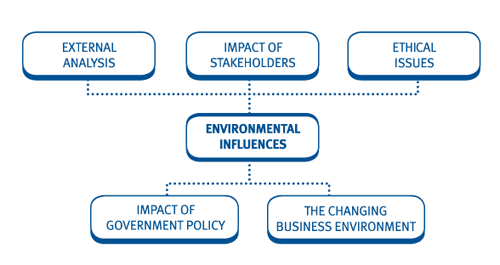
1 Exam focus
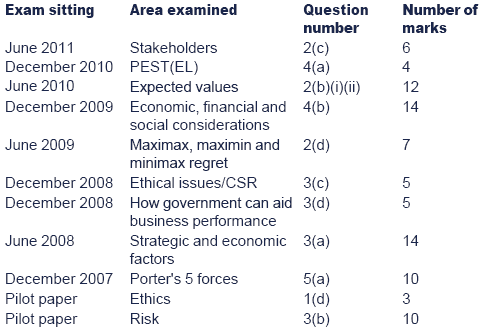
Student Accountant articles: visit the ACCA website, www.accaglobal.com, to review the following articles on the topics in this chapter:
The risks of uncertainty (article 1) - April 2009
The risks of uncertainty (article 2) - October 2009
Business strategy and performance models - April 2006
2 External analysis
2.1 Introduction
External analysis was first met in paper F1 and then studied in more detail in paper P3.
External analysis forms an important part of the 'strategicanalysis' stage of the strategic planning process (reviewed in chapter1).
External analysis can be performed at different levels:
2.2 PEST(EL) analysis
Exam focus: The key issue in P5 is to appreciate that, aswell as being used for strategic analysis, this model can be used toidentify key performance management issues. For example:
- To identify CSFs and KPIs.
- Targets may need revising if market conditions change.
The model
Political
Economic
Social
Technological
Ecological/environmental
Legal

 PEST(EL) analysis
PEST(EL) analysis
Environmental legislation may have been identified as beingparticularly important to a chemicals producer, in which case it shouldset up a series of targets to measure compliance. For example:
- level of fines
- number of environmental prosecutions
- number of environmental enforcement actions
- number of 'notifiable' incidents (local legislation will define what is 'notifiable' and what is not)
- percentage of employees working within an ISO 14001 compliant Environmental Management System
- the firm's rating in independent benchmarking such as the 'Business in the Environment' Index.

2.3 Porter's 5 forces
Exam focus: As with PEST(EL) analysis above, Porter's fiveforces model can be used to identify key performance management issuesas well as being used for strategic analysis.
The model
Porter's five forces analysis applies to industry sectors. Allbusinesses in a particular industry are likely to be subject to similarpressures that determine how attractive the sector is.

 Porter's 5 forces
Porter's 5 forces
- Competitive rivalry: There will be a tough environment if there are many competitors but a much easier one if there is a monopoly.
- Buyer's bargaining power: A few, large customers can exert powerful bargaining power. Many, small customers find it harder to apply pressure.
- Supplier's bargaining power: A monopoly supplier of a vital component can apply great pressure. Any one of many supplies of an ordinary component cannot.
- Threat from potential entrants: The key issue here is to assess barriers to entry. For example, high capital costs, know-how and regulation all present barriers to entry which will help to reduce competition.
- Threat from substitutes: The level of the threat is determined by relative price/performance.
If they are able to, businesses should:
- avoid business sectors which are unattractive because of the five forces
- try to mitigate the effects of the five forces. For example, supplier power is lessened if a long-term contract is negotiated or competition is reduced by taking over a rival.


 Illustration 1 – Porter's 5 forces
Illustration 1 – Porter's 5 forces
A Porter's five forces analysis may have concluded thatthere is currently a low threat of new entrants due to the incumbentfirm having economies of scale that create an effective barrier toentry. The firm concerned would be wise to monitor its cost per unitcompared to those of potential new entrants to see if the threatincreases.


 Test your understanding 1
Test your understanding 1
PEST(EL) and Porter's 5 forces
In the United Kingdom, railways are facing major challenges.Customers are complaining about poor services. The government isreluctant to spend vast amounts of public money on developing thedecaying infrastructure. The inflated costs of commuting by car, such asfuel and congestion charges, are increasing the number of peoplewanting to use the railways.
Required:
Construct an outline PEST(EL) analysis and briefly apply Porter's 5 forces to the railways in the UK.

Question focus: Now attempt question 2 from chapter 13.
3 The impact of stakeholders
3.1 Introduction
As you are well aware, the stakeholders of an organisation are anyone affected by the organisation:
The mission and objectives of an organisation need to be developed with the needs of the stakeholders in mind.

 Illustration 2
Illustration 2
Strategic planning and stakeholder needs
When planning, management has to take into account stakeholderrequirements, power and ambition. For example, there is no pointdevising changes to production methodologies if:
- employees will not be prepared to adapt to them
- customers do not like the quality of what is offered
- suppliers cannot supply parts at the required frequency.

3.2 Stakeholder mapping
Managers can make use of Mendelow's matrix to help manage stakeholders.

 Expandable text - Mendelow's matrix
Expandable text - Mendelow's matrix
- Key players: These stakeholders are the major drivers of change and could stop management plans if not satisfied. Their participation in the planning process is vital.
- Keep satisfied: These stakeholders have high power and need to be reassured of the outcome of the strategy well in advance to stop them from gaining interest.
- Keep informed: These stakeholders are interested in the strategy but lack power. Managers must justify their plans to these stakeholders. Otherwise they will gain power by joining forces with other stakeholders.
- Minimal effort: These stakeholders lack interest and power and are more likely than others to accept what they are told and follow instructions.

3.3 Stakeholders influence on business performance
Stakeholders can influence business performance in a number of ways. For example:
- Control of strategic resources - e.g. workers may go on strike and so withold their labour.
- Possession of knowledge or skills - e.g. by the partners in a joint venture.

 Illustration 3 – Stakeholders influence
Illustration 3 – Stakeholders influence
British Airways plc has regular labour relations problems withcabin attendants and check-in staff. These employees would be classed as'key players' in Mendelow's matrix. The airline cannot operatewithout check-in staff, and particularly without legal minimum numbersof cabin attendants. So, these employees have great power and have shownover many years that they are happy to exercise that power.


 Test your understanding 2
Test your understanding 2
Chatman Theatre is a charitable trust with the objective of makingmulticultural films and stage productions available to a regionalaudience. The organisation is not for profit. The aim to bring diversityof films, plays and dance that would otherwise be inaccessible to aregional audience.
The theatre needs to have strict budget focus, since a charity canbecome bankrupt. In order to achieve the required income, relationshipsmust be built with a range of stakeholders.
Required:
Identify a few key stakeholders and ideas that would assist in building relationships.

3.4 Stakeholder conflict
Stakeholders' requirements and aspirations often conflict:
Resolving conflicting objectives (Cyert and March)
Management can seek to manage conflicting objectives through the following.
- Prioritisation
- Negotiation and 'satisficing'
- Sequential attention
- Side payments
- Exercise of power

 Resolving conflicting (Cyert and March)
Resolving conflicting (Cyert and March)
Prioritisation – this could follow from Mendelow's matrix above.
Negotiation and 'satisficing' – finding the minimum acceptable outcome for each group to achieve a compromise.
Sequential attention – each period a different stakeholdergroup is focused upon, e.g. the workers' canteen could be updated thisyear with the implication that employees should not expect anyimprovements in working conditions for the next few years.
Side payments – this can often involve benefiting a groupwithout giving them what they actually want, e.g. the local communitymay be concerned with cuts in jobs and increased pollution but the firmseeks to placate them by building new sports facilities and sponsoring alocal fete.
Exercise of power – when a deadlock is resolved by a senior figure forcing through a decision simply based on the power they possess.


 Test your understanding 3
Test your understanding 3
The trustees of a museum are faced with the following conflicting objectives:
- to educate the public
- to preserve antiquities for study and research.
Give two examples of policies that would be affected by the prioritisation of these objectives.

4 The impact of ethical issues
4.1 Ethics
Businesses should be ethical. Apart from any moral duty to beethical, the prime purpose of a business is to maximise shareholderwealth and the chance of this happening is increased by the adoption ofethical behaviour.
Considerations
Is it ethical to:
- Experiment on animals?
- Drill for oil?
- Build roads through the countryside?
- Allow smoking in public areas?
- Pay senior executives large increases in salary?
- Train students to pass exams?

 Test your understanding 4
Test your understanding 4
How can the adoption of ethical behaviour by an organisation help to assist to maximise shareholder wealth?


 Illustration 4 - Nestle and Ethics
Illustration 4 - Nestle and Ethics
Nestle was criticised in the past for taking advantage of the poorand uneducated populations in developing countries in order to increasetheir own profits.
The company gave gifts and incentives to local health officials, asencouragement in promoting their baby milk formula and thereforediscouraging breast feeding. Nestle employees were heard tellingmidwives that 'all western women use formula to feed their babies, sothat they grow up big and strong'.
Nestle didn't educate mothers about sterilising bottles andtherefore mothers mixed the formula with dirty water at the cost of manybabies' health. The free samples provided to mothers in hospitals andclinics soon dried up and mothers then had to pay almost western pricesfor the baby milk formula, a price that most families could not afford.

4.2 Corporate social responsibility
 Corporate social responsibility (CSR)refers to the idea that a company should be sensitive to the needs ofall stakeholders in its business operations and not just shareholders.Stakeholders will be given more than the legal minimum that they areentitled to, e.g. the business pays more than the market wage rate indeveloping countries.
Corporate social responsibility (CSR)refers to the idea that a company should be sensitive to the needs ofall stakeholders in its business operations and not just shareholders.Stakeholders will be given more than the legal minimum that they areentitled to, e.g. the business pays more than the market wage rate indeveloping countries.
By aligning the company's core values with the values of society,the company can improve its reputation and ensure it has a long termfuture.
Benefits of a CSR strategy
- Differentiation - the firm's CSR strategy can act as a method of differentiation.
- High calibre staff will be attracted and retained due to the firm's CSR policies.
- Brand strengthening - due to the firm's honest approach.
- Lower costs - can be achieved in a number of ways, e.g. due to the use of less packaging or energy.
- The identification of new market opportunities and of changing social expectations.
- An overall increase in profitability as a result of the above - project NPVs will increase due to increased sales, lower costs, an extended project life and a lower level of risk.

 Test your understanding 5
Test your understanding 5
Many commentators believe that CSR is a morallycorrect pursuit, but there are powerful arguments against it. Identifyand discuss these arguments.

CSR and metrics
The company should measure the result of any CSR programme.

 Test your understanding 6
Test your understanding 6
RFG Inc has set up manufacturing plants in many developingcountries, some of which have much lower legislation standards regardinghealth and safety than RFG's target markets. To improve its globalreputation, the firm wishes to improve its performance for health andsafety.
Suggest some metrics for measuring health and safety.

5 The impact of government policy
5.1 Introduction
Government policies will influence the performance levels achievedby an organisation and the performance measurement techniques chosen.

 Test your understanding 7
Test your understanding 7
Evaluate the circumstances in which a government can act as an aid to business performance.


 Illustration 5 - The role of government policy
Illustration 5 - The role of government policy
The capital engaged in some business operations is a directfunction of relations with government. The following is an extremeexample of this.
The UK Independent Television regional franchises were 'auctioned'in the early 1990s. The system is that a public body owns thetransmitter network but franchises the right to broadcast programmes(and advertising) from regional centres every 10 years. Organisationsinterested in obtaining a franchise were required to submit sealed bidsprior to certain dates. Those bids stated (among other things) theamount that the applicant was prepared to pay for the franchise.
Some of the franchises were keenly contested – particularly someof the more attractive ones in London and the south east. Severalwell-resourced consortia offered substantial nine-figure sums for theLondon franchises.
One organisation, Central Television, was preparing a bid for theBirmingham franchise. Through discreet enquiries it found that no otherbids were going to be made for the franchise. So, it submitted a bid for£2,000 – which the government had to accept. A rich franchise, worthmillions, was thereby acquired without any significant capital outlay.
The performance of Central Television on the basis of ROCE wouldhave been phenomenal – but this had nothing to do with commercialsuccess or efficiency. It was just an accident of the way that theindustry is regulated.


 Porter's view
Porter's view
The influence of government on an industry
Porter identifies seven ways in which a government can affect the structure of an industry.
- Capacity expansion. The government can take actions to encourage firms or an industry as a whole to increase or cut capacity. Examples include capital allowances to encourage investment in equipment; regional incentives to encourage firms to locate new capacity in a particular area, and incentives to attract investment from overseas firms. The government is also (directly or indirectly) a supplier of infrastructure such as roads and railways, and this may influence expansion in a particular area.
- Demand. The government is a major customer of business in all areas of life and can influence demand by buying more or less. It can also influence demand by legislative measures. The tax system for cars is a good example: a change in the tax relief available for different engine sizes has a direct effect on the car manufacturers' product and the relative numbers of each type produced. Regulations and controls in an industry will affect the growth and profits of the industry, for example minimum product quality standards.
- Divestment and exit. A firm may wish to sell off a business to a foreign competitor or close it down, but the government might prevent this action because it is not in the public interest (there could be examples in health, defence, transport, education, agriculture and so on).
- Emerging industries may be controlled by the government. For instance governments may control numbers of licences to create networks for next generation mobile phones.
- Entry barriers. Government policy may restrict investment or competition or make it harder by use of quotas and tariffs for overseas firms. This kind of protectionism is generally frowned upon by the World Trade Organisation, but there may be political and economic circumstances in which it becomes necessary.
- Competition policy. Governments might devise policies which are deliberately intended to keep an industry fragmented, preventing one or two producers from having too much market share.
- New product adoption. Governments regulate the adoption of new products (e.g. new drugs) in some industries. They may go so far as to ban the use of a new product if it is not considered safe (a new form of transport, say). Policies may influence the rate of adoption of new products, e.g. the UK government intends to 'switch off' the analogue television networks by the year 2012, effectively forcing users to buy digital cable or satellite services.


 Legislation and regulation
Legislation and regulation
Strategic planners cannot plan intelligently without a good workingknowledge of the laws and regulations that affect their own companiesand the businesses they operate in.
- There is an almost endless list of laws, or categories of legislation, that affect business enterprises in domestic, national or international dimensions. The main categories are listed below:
- local by-laws (for example planning permission, construction of roads, licences)
- labour legislation (such as safety at work, employee protection, redundancy payments)
- trade union legislation
- consumer protection legislation
- company legislation
- taxation legislation
- anti-trust (monopolies) legislation and rulings
- trade legislation (e.g. countries restricted for export)
- business legislation (e.g. contract and agency law)
- social legislation such as welfare benefits.
- At a more general level, laws are passed that enable government to levy taxes which will have an impact both on demand and the organisation's profits.
- There are special regulatory regimes for particÂular industries or sectors, such as nuclear energy, transport, broadcasting or food.
- Legislation is becoming more complex, particularly for those companies that trade internationally where the interface, indeed probable conflict, between domestic laws, the host country's laws, and probably also the laws of the trading block of nations the host country belongs to, provides an extremely complicated legal scenario.


 Government and the public sector
Government and the public sector
In public sector organisations the government is the major stakeholder. This can have a number of particular impacts:
- the motivation to meet customer needs may be reduced
- the consequences of failure to provide an appropriate level of service for the organisation and the individual are reduced
- being dependent on government policy also means that objectives may change rapidly as policy changes and this political dimension reduces the scope of management options and increases the time for decisions to be taken
- when the public sector companies are privatised they may still remain subject to elaborate regulatory regimes. The performance of the operations involved is monitored and measured using various indicators, with the possibility of fines for poor performance or price restrictions imposed by regulators.


 Planning for political change
Planning for political change
The problem facing strategic planners is how to plan for changes inthe political environment. It is necessary to consider what type ofpolitical change could affect the enterprise rather than trying toestimate all the political changes that might occur, by:
- examining changes in social behaviour and values, economic activity, and problems arising from the physical infrastructure or environment which can be related to the trend of political actions
- monitoring indicators of possible or intended future government actions and policy. These indicators are obtained from:
- annual conferences of political parties
- public utterances of party leaders and seniors
- international events
- directives from international trading groups
- political commentators and analysts
- international summit meetings
- staged legislation
- efforts of public pressure groups (particularly with regard to local government policy)
- political manifestos.


 Test your understanding 8
Test your understanding 8
Give some examples of areas of government policy thatare likely to affect a multinational electronics company and how theimpact will be felt?

5.2 The impact of fiscal policy and monetary policy
Fiscal and monetary policies are the tools used by governments to control their economies.
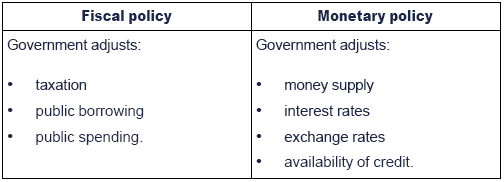
Fiscal policy
- Looks at the balance between government income (taxation + borrowing) and expenditure.
Monetary policy
- Is the process by which the government and central bank controls the supply, availability and cost of money.

 Fiscal and monetary policy - more detail
Fiscal and monetary policy - more detail
Fiscal policy
- To stimulate the economy, the government can spend more money. However, if the extra expenditure is met by raising taxes, the public will have less to spend and economic growth will be small. To really get things moving, the government needs to borrow and spend.
- The economy can also be stimulated by cutting tax and allowing individuals to spend more. If government expenditure is cut to match the tax cuts, there will be little stimulation, so government borrowing is needed to keep government spending high.
- Too much economic stimulation is likely to cause inflation as consumers compete for resources and services.
Monetary policy
Changes in monetary policy will influence the following factors.
- The availability and cost of finance. These in turn affect the level of investment and expenditure by firms.
- The level of consumer demand e.g. low interest rates will stimulate the economy as it is cheaper to borrow and savings do not earn a lot of interest. Similarly, the easy availability of credit also encourages borrowing and spending).
- The level of inflation.
- The level of exchange rates.


 Impact of macroeconomics
Impact of macroeconomics
In order for macroeconomic policy to work, its instruments musthave an impact on economic activity. This means that it must affect thebusiness sector. It does so in two broad forms.
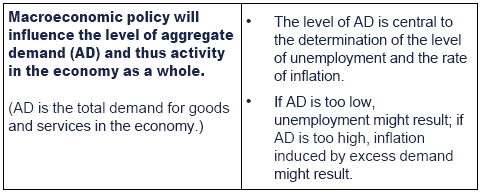
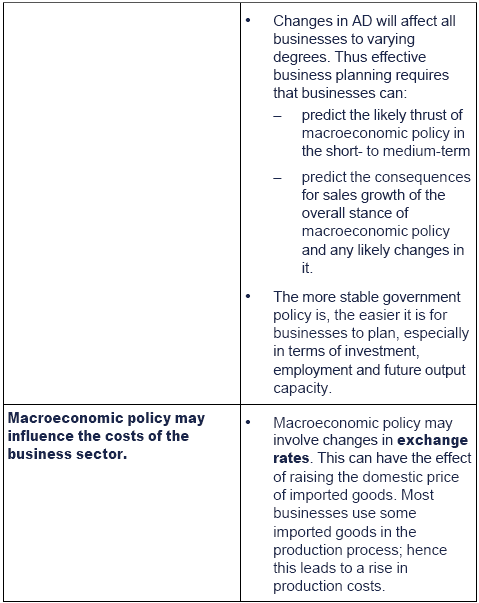



 Test your understanding 9
Test your understanding 9
A carpet retailer imports carpets and sells themdomestically. The domestic currency does not have a fixed exchange ratewith any other currency. What are the likely effects on this business ofa rise in domestic interest rates?


 Test your understanding 10
Test your understanding 10
Suppose the two main political parties in a hypothetical country have the following priorities:
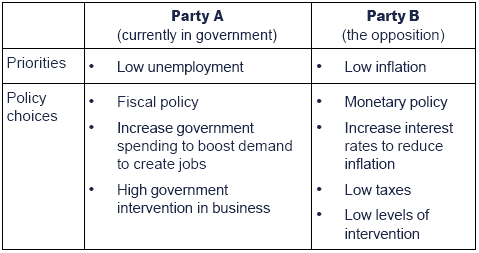
Recent polls suggest that Party B could win the next election.
Comment on the implications of this for a major construction company based in the country concerned.

6 The impact of government regulation
6.1 Introduction
Government regulation affecting businesses includes:
- competition policy
- supply-side policies
- green policies/externalities.
6.2 Competition policy
Monopolies
Most governments consider the disadvantages of monopolies to outweigh the advantages.


 Disadvantages/advantages of monopolies
Disadvantages/advantages of monopolies
Disadvantages to the economy as a whole:
- Supernormal profits: the lack of competition allows monopolists to charge high prices at the expense of customers.
- Economic inefficiency: output is produced at a higher cost than necessary. For example, there may be no incentive to reduce costs by improving technology used.
- Monopolies may be able to engage in price discrimination: charging different prices to different customers for the same good or service, e.g. peak and off-peak pricing. This may act against the interests of customers.
- Disincentive to innovate: the absence of competition may reduce the incentive to develop new products or new production processes.
- Pricing practices: monopolies may adopt pricing practices to make it uneconomic for new firms to enter the industry, thus reducing competition in the long run.
Possible Advantages:
- Large firms may secure economies of scale: it is possible that there are significant economies of scale, reducing production costs, but that these require large firms and hence the number of firms in an industry is restricted.
- The special case of natural monopolies: this is the case where the economies of scale in the provision of some basic infrastructure are so great that only one producer is feasible. This may be the case of the public utilities in energy and water.
- Research and development (R&D): it may be that monopoly profits are both the reward for, and the source of finance for, technological and organisational innovation. Thus some static welfare losses have to be accepted in order to ensure a dynamic and innovative business sector.

Possible government responses to monopolies:
- The control of monopolies, e.g. the UK Competition Act prohibits anti-competitive agreements (such as illegal cartels) and prohibits the abuse of a dominant position (at least 40% of the market).
- Public regulation, e.g. Ofgen now regulates the gas and electricity markets in Great Britain. Public regulation is discussed in more detail below.
- Self-regulation, e.g. of the accounting and legal professions.
- Public provision through nationalisation, e.g. nationalisation of a number of key UK banks in 2008/9.
Public regulation
Many governments tried to increase the efficiency and performanceof state-owned monopolies by privatisation, e.g. UK utilities wereprivatised in the 1980s.
Privatisation needs to be controlled through the activities of an industry regulator.

 Privatisation
Privatisation
The regulator has to balance the following issues:
- protecting customer interests
- ensuring sufficient investment in infrastructure
- controlling quality (e.g. in the case of water utilities, water quality and the treatment of sewerage)
- ensuring shareholders and other investors achieve a reasonable return
- ensuring that the firm has, or can raise, the necessary funds for investment.
These are usually controlled by:
- setting a limit on price increases
- agreeing investment targets
- putting in place a detailed framework of KPIs that the firm must achieve to retain its licence and to avoid fines.


 Test your understanding 11
Test your understanding 11
Discuss whether and how a regulated water utilities company can improve its ROCE.

6.3 Supply-side policies
- Supply-side economists take the view that the supply of suitable, cost-effective and adequate materials, services and labour is vital to an economy.
- If these resources are made available, then they will be used to produce goods and services.
- The amounts paid to suppliers and employees will create the extra income necessary to buy the extra outputs.
- For example improving education would increase the supply of educated workers in the workforce.

 Supply side policies examples
Supply side policies examples
Supply-side policies are therefore largely anti-regulation andanti-government interference. For example, supply-side economists wouldclaim that:
- wage regulation prevents the labour market from achieving full employment
- government grants encourage weak businesses
- employment legislation limits risk taking and can lead to over-manning of industries
- high taxes act as a disincentive to work and enterprise and lead ultimately to lower output, employment and wealth.

6.4 Green policies/externalities
The need for green policies arises from the existence of external environmental costs associated with some forms of:
- production, e.g. river pollution from manufacturing
- consumption, e.g. car emissions causing air pollution.
The producer or consumer may not bear the full cost of their actions (negative externality).
As a result, the government may impose green policies, e.g. an increase in tax on fuel.
7 The changing business environment
7.1 The relevance of traditional management accounting techniques
- Many organisations are facing business environments that are changing, e.g. due to greater globalisation.
- These developments have resulted in the introduction of new management accounting practices and the modification of old ones.
- There are a number of sources of information for the management accountant who wants to learn about new techniques. For example:
- articles published in professional journals and the press
- studies published in specialised journals
- information provided by professional bodies
- networking and exchanging ideas
- seminars
- tv, radio, books and the Internet.
Burns and Scapens recognised that that there have beenchanges in the environment in which management accountants work, forexample increased globalisation and increased use of IT.
The changes have a number of implications for the roles and skills of management accountants:
- there is likely to be a shift towards a more strategic role working alongside operational managers
- increasingly management accountants will work in cross-functional teams which will demand good interpersonal skills
- they need a broad understanding of business and improved commercial skills
- they will need to consider the broader picture and make use of non-financial, as well as financial, information
- they will need to make use of existing techniques and skills but apply them to a non-financial context.

 Role of a management accountant
Role of a management accountant
A scan of current job advertisements for management accountants would show that they are frequently being asked to:
- inform strategic decisions and formulate business strategies
- lead the organisation's business risk management
- ensure the efficient use of financial and other resources
- advise on ways of improving business performance
- liaise with other managers to put the finance view in context
- train functional and business managers in budget management
- identify the implications of product and service changes
- work in cross-functional teams involved in strategic planning or new product development.

7.2 Risk and uncertainty
 Risk is the variability of possible returns.
Risk is the variability of possible returns.
All business face risk. Risk management is the process ofunderstanding and managing the risks that an organisation is inevitablysubject to.
 Exogenous variables are variables that do not originate from within the organisation itself and are not controllable by management.
Exogenous variables are variables that do not originate from within the organisation itself and are not controllable by management.
- We have seen several examples of exogenous variables in this chapter, e.g. government policy, economic factors, social factors.
- The existence of such variables means that long-term strategic planning always involves an element of risk and uncertainty.

 Illustration 6 - The impact of exogenous variables
Illustration 6 - The impact of exogenous variables
A hospital has developed a new surgical technique as a moreexpensive alternative to existing treatments. It is considering whetherto begin to provide the treatment to all its patients, which would meanbuilding a new facility. In order to inform the decision, the hospitalis considering the likely effect of a number of variables.
- The likelihood that another alternative cheaper treatment, either a surgical technique or a drug regime, will be discovered.
- The likelihood that other hospitals will begin to offer similar services which will limit demand.
- Government policy – changes in the way that treatment is funded and therefore whether the costs of the treatment will be paid for.

Tools for incorporating risk and uncertainty
There are a number of tools which can be used to incorporate the impact of uncertain factors:
- Scenario planning - this looks at a number of different but plausible future situations. For example, Shell was the only major oil company to have prepared for the shock of the 1970s oil crisis through scenario planning and was able to respond faster than its competitors.
- Computer simulations - this is a modelling technique which shows the effect of more than one variable changing at a time and gives management a view of the likely range and level of outcomes so that a more informed decision can be taken.
- Sensitivity analysis - this takes each uncertain factor in turn, and calculates the change that would be necessary in that factor before the original decision is reversed.
- Expected values (EVs) - an EV shows the weighted average of all possible outcomes and is a useful method for when a decision is repeated many times. The main drawback is that it ignores the variability (i.e. the risk) in the range of potential outcomes.
- Maximin, maximax and minimax regret - these are three different tools for incorporating risk/uncertainty. The attitude of management towards risk will determine which of the three tools is used.
EVs and maximin, maximax and minimax regret will be explored in more detail below.
Expected values (EVs)
An EV is calculated by multiplying the value of each possibleoutcome (x), by the probability of that outcome (p), and summing theresults.
EV = ∑px
A matrix can be a useful way to represent and analyse a scenariowhere there is a range of possible outcomes (combined probabilities) anda variety of possible responses.

 Test your understanding 12
Test your understanding 12
Confused Ltd is seeking to establish the likely profit to begenerated from the forthcoming year. This is very much dependent uponthe anticipated demand, and the impact of Inflation upon the fixed costsof the business.
Probabilities have been estimated for both demand and Inflation as shown below.

A two way data table has been prepared which estimates the changes in net profit for a range of changes in demand and inflation:

Required:
Prepare a summary that shows:
- the range of possible net profit and loss outcomes
- the combined probability of each outcome
- the expected value of the profit for the year.
Management will be awarded a bonus if profit exceeds $50,000. What are the chances of this occurring?

Maximin, maximax and minimax regret
The maximin rule involves selecting the alternative thatmaximises the minimum pay-off achievable. This approach is suitable for apessimist (risk averse decision maker) who seeks to achieve the bestresults if the worst happens.
The maximax rule involves selecting the alternative thatmaximises the maximum pay-off achievable. This approach would besuitable for an optimist (risk seeking decision maker) who seeks toachieve the best results if the best happens.
The minimax regret strategy is the one that minimises the maximum regret, i.e. the opportunity loss through having made the wrong decision.

 Test your understanding 13
Test your understanding 13
Stow Health Centre specialises in the provision of exercise anddietary advice to clients. The service is provided on a residentialbasis and clients stay for whatever number of days suits their needs.
Budgeted estimates for the year ending 30 June 20X9 are as follows:
- The maximum capacity of the centre is 50 clients per day for 350 days in the year.
- Clients will be invoiced at a fee per day. The budgeted occupancy level will vary with the client fee level per day and is estimated at different percentages of maximum capacity as follows:

- Variable costs are also estimated at one of three levels per client day. The high, medium and low levels per client day are $95, $85 and $70 respectively.
The range of cost levels reflects only the possible effect of the purchase prices of goods and services.
Required:
(a)Prepare a summary which shows the budgetedcontribution earned by Stow Health Centre for the year ended 30 June20X9 for each of nine possible outcomes.
(b)State the client fee strategy for the yearto 30 June 20X9 which will result from the use of each of the followingdecision rules: (i) maximax; (ii) maximin; (iii) minimax regret. Youranswer should explain the basis of operation of each rule. Use theinformation from your answer to (a) as relevant and show any additionalworking calculations as necessary.

Risk appetite of stakeholders
Stakeholders will have different appetites for risk. For example:
- Shareholders - investing in shares is often viewed as risky since there is no guaranteed return. However, shareholders can choose their investments and can spread their risk by holding a portfolio of investments.
- Employees and managers - they should act in the best interests of the shareholders but this does not always happen since they may be:
- risk averse: employees and managers may be reluctant to take risks, e.g. to invest in a new project, if an unsuccessful outcome would impact their performance evaluation or the survival of the company (and hence their job). Therefore, even though risk taking may be in the best interests of the company and its shareholders they tend to exercise caution and are unwilling to take risks.
- risk seeking: employees and managers may be encouraged to take risks by the promise of huge rewards or bonuses.

 Illustration 7 - Risk appetite of employees
Illustration 7 - Risk appetite of employees
In 2008, the governor of the bank of England, Mervyn King,criticised City banks who rewarded staff with huge sums for taking risksand concluded that the credit crisis was caused by bankers betting onhigh-risk complex financial products.

Chapter summary
Test your understanding answers

 Test your understanding 1
Test your understanding 1
PEST(EL) Analysis for UK railways
Political
The balance of public - private involvement in the running costs and capital investments for rail development is a major issue
Economic
The growth of commuter travel on the rail system means it isworking at close to full capacity. This trend is likely to continue withthe rising costs of fuel, making car travel expensive.
There is a need for investment in infrastructure in areas such aslonger platforms and new signal systems. Financing this investment maybe difficult.
Social
Increasing concerns about reliability, particularly in rural areas.
Concerns about the effect that railway construction and travel has on the environment.
Safety issues on trains and at railway stations.
Technological
The development of new train technologies such as the tilting train.
Also following the trends set by air travel by introducing ways toimprove the customer experience. For example, offering internet accessand on-train entertainment.
Environmental
Environmental impact of major infrastructure developments is a key issue.
Legal
The legal framework for the regulation and power of the railways is a major issue for operators.
Conclusion
Overall, the switch to rail travel is seen to have a positiveenvironmental impact, reducing the congestion and pollution associatedwith car based travel.
Porter's 5 forces - UK railways
Competitive rivalry
In certain areas rail operators may be directly competing over the same routes.
Threats from substitutes
There are other forms of transport available such as travel by road (e.g. cars and buses) and travel by air.
Buyer's bargaining power
Severe competition over price with low-cost airlines on longer city routes.
Online price comparisons make it easy for customers to select lowest cost option.
Threat from potential entrants
New companies may enter the market when rail franchises becomeavailable for re-tender. For example, Virgin entered the UK market someyears ago.
Supplier's bargaining power
With an increasing number of discrete rail and train operators, theallocation of capacity becomes an issue. This is similar to landingslots at airports.


 Test your understanding 2
Test your understanding 2
Loyal customers
Chatman Theatre, which is a charity, can use of a database toprofile their interests and wants. A tailored communication can then besent.
Given the need to contain costs, this might be by getting customersto sign up to e-list to get up-to-date news and information on futureperformances.
They could set up a website with booking facilities and send confirmation by email rather than post.
Develop a friend of the theatre group, giving discounts to regular loyal customers.
First time customers
The website could be linked to other relevant websites, such as local attractions and tourist boards, to attract new customers.
The theatre could produce an information pack to attract newmailing list subscribers. These could be made available in localchurches and shops.
Local arts groups
A partnership agreement could be established with arts groups, toco-sponsor events of special interest to given groups of customers.
Local organisations
Try to obtain commercial sponsorship from local companies.Acknowledgement could be given in the monthly programme mailings andpreferential facilities offered for corporate hospitality.
Media
Personal invitations could be issued to opening nights, to interview the performers and give an overview of the show.
Note: The above is just a selection of potential relationships with stakeholders.


 Test your understanding 3
Test your understanding 3
- Whether or not the museum should charge an entry fee – this would discourage some people from going to the museum (compromising the first objective) but would provide extra cash for funding research.
- Which artefacts should be displayed – education would require a wide range of exhibits with the most prestigious on display. An emphasis on preservation would prevent the most significant items from being displayed for fear of damage.


 Test your understanding 4
Test your understanding 4
- Ethical behaviour is likely to be favoured by:
- customers: resulting in higher sales volumes and/or prices.
- employees: resulting in the attraction/retention of the best employees and increased employee productivity.
- business collaborators: resulting in increased opportunities for profitable projects.
- Ethical behaviour reduces risk and gives access to cheaper funds which in turn increase project NPVs.
- Unethical behaviour will, at some point be discovered resulting in a damage to reputation and potential legal charges.


 Test your understanding 5
Test your understanding 5
- The purpose of a business is to make profits. Profit is a good thing in its own right as it supports stable employment, innovation, allows higher taxes to be paid and makes economies richer. Companies have no need to feel guilty about making profits and buying off some of that guilt by embarking on good works.
- The prime stakeholders are the shareholders and directors should always attempt to maximise shareholder wealth. If directors embark on a CSR programme, have shareholders given permission? It is, after all, shareholders' money that is being used.
- CSR allows directors to feel generous and righteous – but with someone else's money. Better, perhaps, that directors and shareholders make private donations out of their remuneration and dividends.
- What is the democratic basis which companies use to choose between CSR projects? Simply choosing a project because the chief executive likes it does not mean the money is being well spent – the project could be already well-funded.


 Test your understanding 6
Test your understanding 6
Suitable metrics could include:
- number of fatalities
- number of permanently disabling injuries
- number of enforcement actions
- accident frequency rate (AFR) e.g. the number of reportable accidents per 100,000 hours worked
- lost time incident frequency rate (LTIFR)
- sickness absence rate
- health and safety training rate (days/employee)
- percentage of employees working within an ISO 18001 compliant Health and Safety Management System.


 Test your understanding 7
Test your understanding 7
Governments can act as an aid to business performance in the following ways:
- A government can increase aggregate demand for goods and services by increased government spending and/or by reducing taxation so that firms (and individuals) have more income available to spend.
- Government policy may encourage firms to locate in particular areas. This is particularly the case where there is high unemployment in such areas.
- Government policy via the use of quotas and import tariffs might make it more difficult for overseas firms to compete in domestic markets.
- A government can regulate monopolies in particular with regard to the prices they charge and the quality of their goods and services.
- Government policy can regulate the activities of those firms which do not act in the best interests of the environment.


 Test your understanding 8
Test your understanding 8
Areas could include:
Interest rates
Changes in the interest rates for consumer debt may affect demandfor luxury goods which may include high-value electronic products.
The company's cost of debt may change, affecting the cost of developing new facilities.
Exchange rates
Changes in interest rates may change the value of profits earned indifferent countries or the price to consumers of imported goods.
Taxation levels
The level of personal taxation will affect the demand for products.Changes in the company tax regime will affect the returns toshareholders.
Incentive schemes
The availability of incentive schemes may make expanding into certain countries more attractive.
Worker protection
Legislation in this area may have an impact on the requirements for facilities and their costs.
Restrictive practices
These may affect the company's ability to export to certain countries.
Environment protection
The company may need to develop new products which are moreeconomical to run or which use materials which are less harmful to theenvironment when thrown away.


 Test your understanding 9
Test your understanding 9
(1)Customers' mortgages and loans will becomemore expensive, giving less net disposable income for major purchases,such as new carpets.
(2)Customers will be less ready to borrow to finance carpet purchase.
(3)The cost of capital will rise so the retailer will be less prepared to undertake major projects.
(4)The domestic currency will strengthen, reducing the cost of imports.


 Test your understanding 10
Test your understanding 10
- Higher interest rates will increase the cost of borrowing and the gearing risk of the firm, making it less likely that long-term earnings targets will be met.
- A fall in government spending could see a downturn in orders, particularly if the firm currently is engaged in government contracts (e.g. building roads, hospitals). Future plans may have to be revised to reflect this and alternative strategies sought. Analysis of sales mix between public and private sector contracts will become more important.
- Potentially lower levels of taxation could increase profitability.
- Lower inflation will reduce business uncertainty, making planning easier. Plans may have to be revised to reflect lower inflation.
- Higher unemployment in the economy could allow the firm to reduce planned pay increases.


 Test your understanding 11
Test your understanding 11
Depending on the degree of regulation in the country concerned thefirm could find it difficult to improve performance due to thefollowing:
- It may be difficult to win new customers as the firm already has a regional monopoly.
- Price rises will probably be capped by the regulator.
- Minimum spending plans will be agreed with the regulator. These could be delayed to boost short-term ROCE.
- The formula for calculating ROCE will probably be set by the regulator (e.g. calculation of depreciation, definition of capital employed, adjustments for inflation).
- Quality targets make it difficult to cut corners to reduce operating costs.
These emphasise the importance of negotiating a 'good deal' with the regulator when spending plans are agreed.
The company should also look to developing non-core activities (though these may also be regulated).
- Water sports facilities, such as sailing.
- Whether land could be developed, e.g. building apartments.


 Test your understanding 12
Test your understanding 12
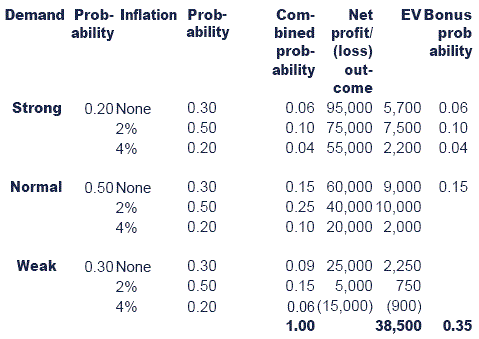


 Test your understanding 13
Test your understanding 13
(a)Budgeted Net Profit/Loss outcomes for year ending 30 June 20X9.
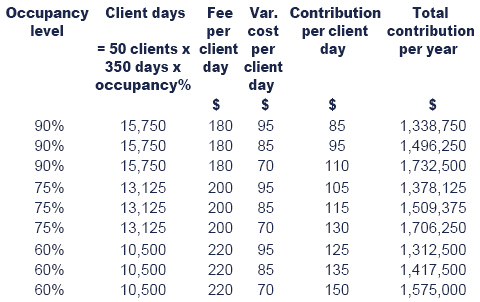
(b)Maximax
Decision: a client fee of $180 per day will maximise the maximum possible contribution at $1,732,500.
Maximin

Decision: a client fee of $200 per day will maximise the minimum possible contribution at $1,378,125.
Minimax regret
Using the calculations from part (a) we may create an opportunity loss (regret) table as follows:

W1 at the high level of variable costs, the best strategywould be a client fee of $200. The opportunity loss from using a fee of$180 or $220 per day would be $39,375 (1,378,125 - 1,338,750) or $65,625(1,378,125 - 1,312,500) respectively.
W2 at the medium level of variable costs, the best strategywould be a client fee of $200. The opportunity loss from using a fee of$180 or $220 per day would be $13,125 (1,509,375 - 1,496,250) or $91,875(1,509,375 - 1,417,500) respectively.
W3 at the low level of variable costs, the best strategywould be a client fee of $180. The opportunity loss from using a fee of$200 or $220 per day would be $26,250 (1,732,500 - 1,706,250) or$157,500 (1,732,500 - 1,575,000) respectively.
Decision: the minimum regret strategy is a client fee $200 per day. This fee minimises the maximum regret at $26,250.

 |
 |
 |
|
Created at 5/24/2012 4:26 PM by System Account
(GMT) Greenwich Mean Time : Dublin, Edinburgh, Lisbon, London
|
Last modified at 5/25/2012 12:55 PM by System Account
(GMT) Greenwich Mean Time : Dublin, Edinburgh, Lisbon, London
|
|
|
|
 |
Rating
:
|
 Ratings & Comments
(Click the stars to rate the page) Ratings & Comments
(Click the stars to rate the page)
|
 |
Tags:
|
|
|
|
|